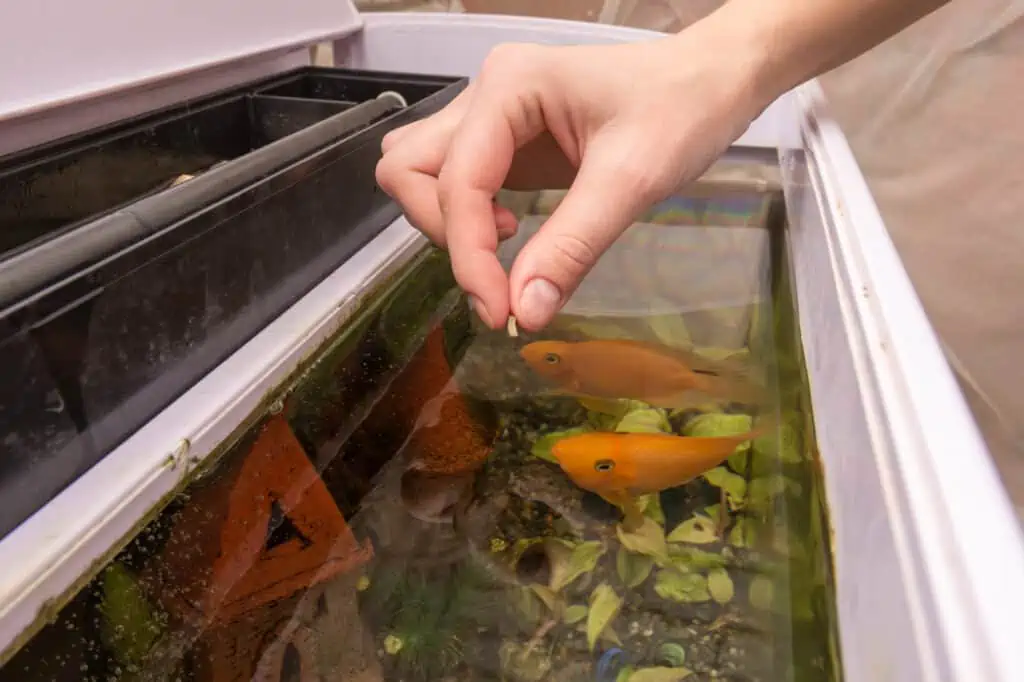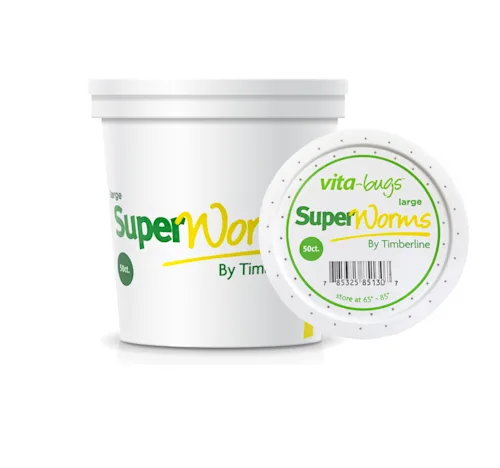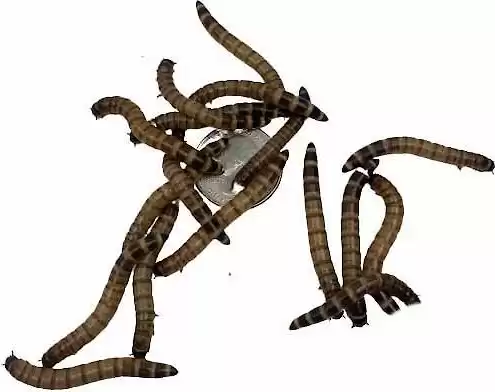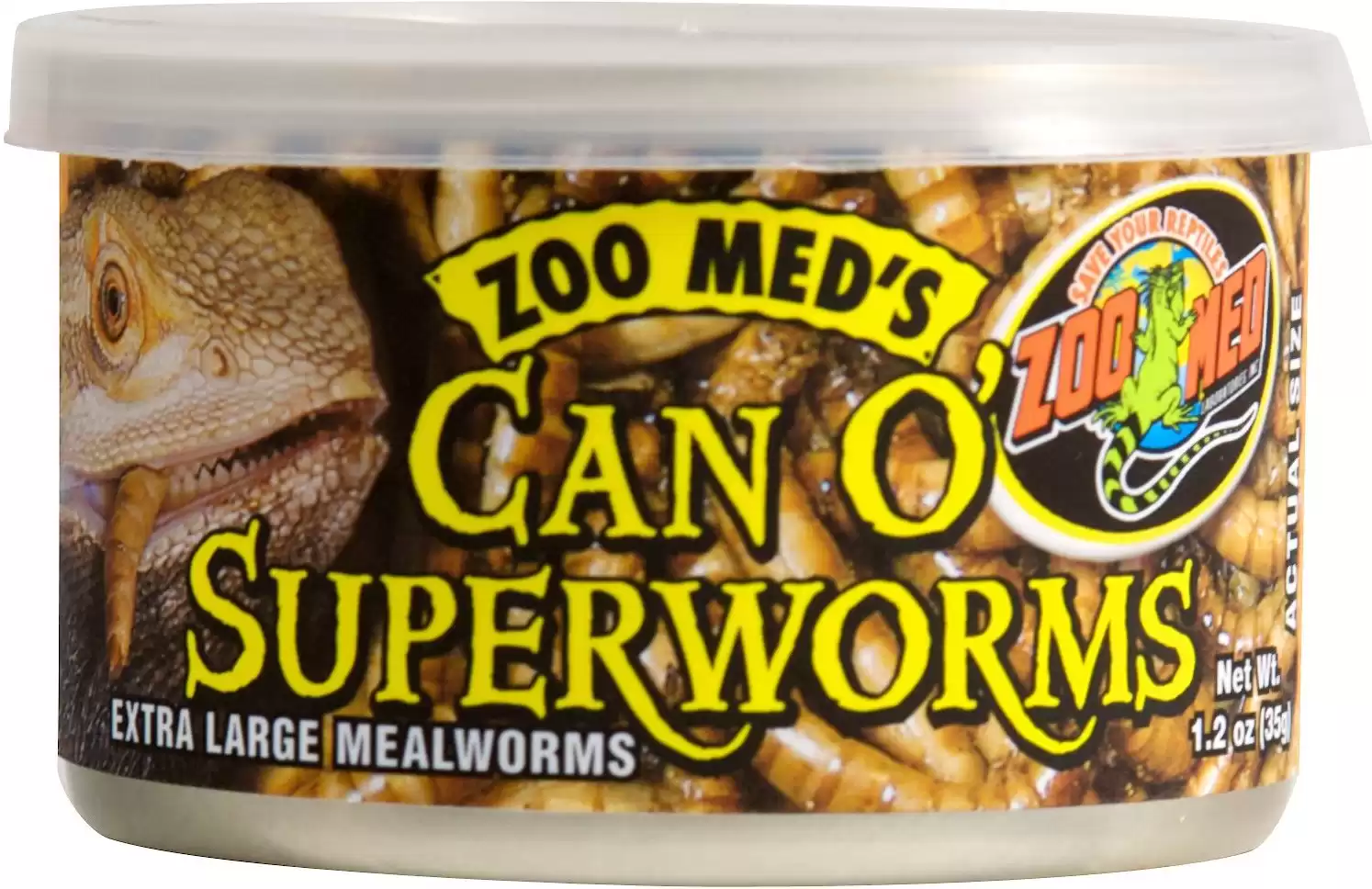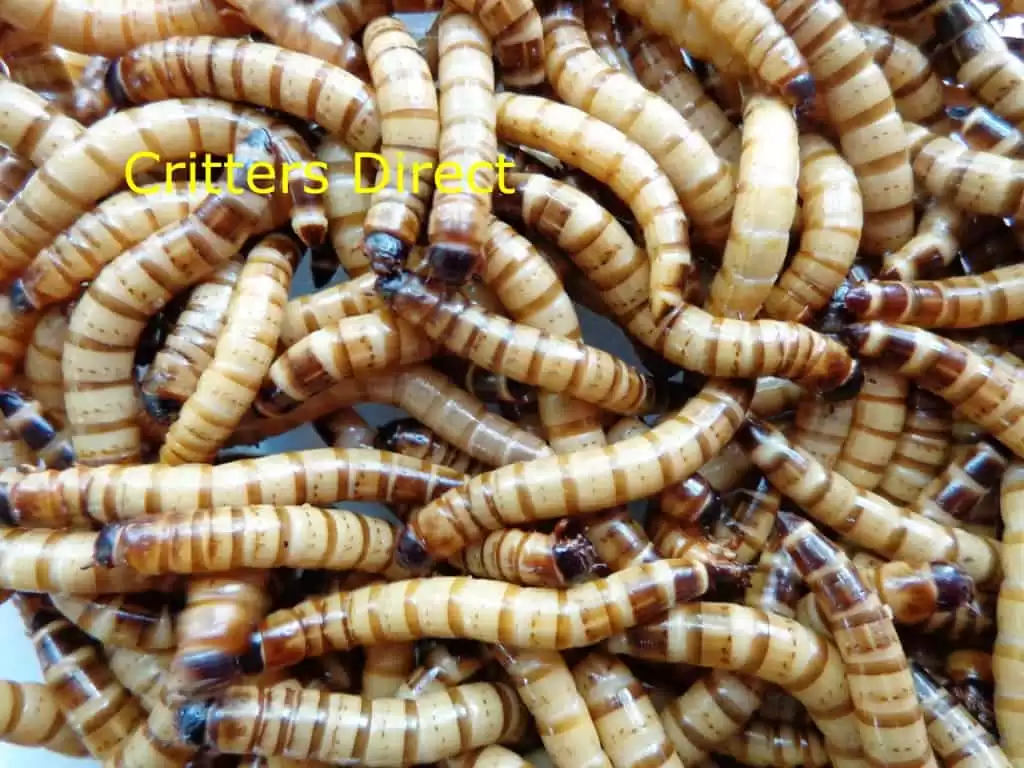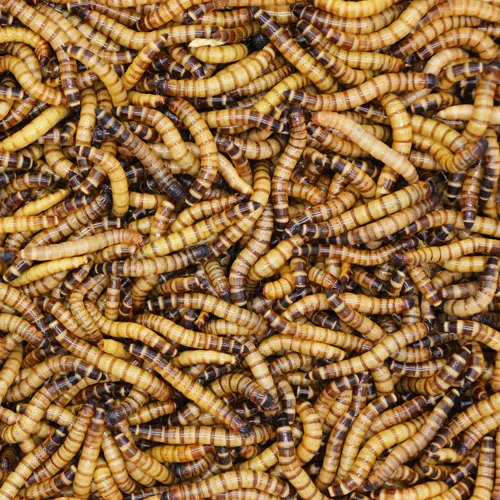If you have carnivorous or omnivorous fish, you most likely feed them bloodworms and other similar meaty protein sources.
This guide discusses Superworms, including how to raise this nutritionally valuable fish food at home. Keep reading for the definitive buyer’s guide to Superworms!
|
4.0
|
3.0
|
3.0
|
What Are Superworms?
Superworms are sometimes called Kingworms or Morio worms, although their scientific name is Zophobas morio.
These worms are commonly used in the pet industry to feed reptiles and resemble large mealworms, growing to around 2.25 inches long when full-grown. However, unlike mealworms, the Superworm’s body is almost black at the ends.
Best Commercially Produced Superworms
In this part of our guide, we take a look at our favorite commercially produced Superworms that are currently available for you to buy.
Critters Direct Live Superworms
- Moisture: 62%
- Protein: 19%
- Fiber: 3%
- Calcium: 173 ppm
Product Features:
- Available in small, medium, and large sizes or a combo of all three
- High in calcium and multivitamins
- Gut loaded with Rep-Cal calcium
- Low protein, high-fat content
- Guaranteed live on arrival
Critters Direct produces a range of worms and other live fish and reptile foods. The worms are well-packaged, so most arrive alive. The Superworms come with clear instructions on caring for and keeping them healthy.
However, some users have commented on a foul odor coming from the packaging and are concerned that the worms might be unfit for feeding their fish.
What We Like:
- Worms appear as advertised
- Most of the worms arrive alive
- Speedy delivery
- Excellent food for fish
Room for Improvement:
- Smell bad
- Tend to break easily
Basset’s Cricket Ranch
- Not just mealworms. These guys are superworms! They are bigger than regular mealworms, and have a hard exoskeleton, making them an excellent source of protein and calcium. When you buy king mealworms online from Bassett’s Cricket Ranch, our superworms are available in either a prepacked cup, or in bulk.
Product Features:
- Between 1” to 2” long
- Live on delivery
- 1lb package weight
- Supplied in bran
Your fish will love these high-quality Superworms and mealworms! The worms arrive well-packaged and are obviously juicy, well-fed, and well-cared-for.
However, a few of the worms arrive dead and the quantities supplied are quite small, so they don’t last long if you have a large tank.
What We Like:
- Large size
- Hardly any odor
- Delivered on time
- Appear to be well cared for
Room for Improvement:
- Worms are somewhat lethargic
- Smaller quantity than expected
AB Dragons Large Superworms
- Grown in the USA.
- Well packaged in a cotton bag with paper.
- Suitable for reptiles, birds, fish and even chickens.
Product Features:
- Grown in the USA
- Well-packaged
- Speedy delivery
These large, lively Superworms are grown in the USA and arrive well-packaged and mostly alive. The worms are in good condition and appear healthy and well-fed.
What We Like:
- Large size
- Hardly any odor
- Speedy delivery
- Juicy and lively!
Room for Improvement:
- Smaller quantity than expected
Zoo Med Can O’Superworms
- Food for your reptile.
- Contains giant mealworms.
- Mealworms are farm-raised.
- Does not contain any artificial colors or preservatives.
Product Features:
- Farm-raised combo of giant mealworms and Superworms
- Contains no artificial preservatives or colors
- Well-packaged for freshness
If you prefer to feed your fish dried foods, these conveniently packaged Superworms and giant mealworms are ideal for you.
The high-protein food contains no artificial preservatives or colors, making this a healthy food for your fishy friends.
What We Like:
- Combination of Superworms and giant mealworms
- Hardly any odor
- No artificial colors or preservatives
Room for Improvement:
- Quite expensive compared with similar products
Vita-Bugs Large Superworms
- Promote enhanced immune response, coloration and improved overall animal health
- Provides increased levels of Vitamin A and Vitamin E with improved Omega-3 fatty acids resulting in improved Omega-6: Omega-3 ratio
- Store at 65 to 85 degrees F
Product Features:
- Extra-large live Superworms
- Available in various size packages
- Quick, reliable delivery
These large Superworms are shipped to your door by overnight courier to ensure they arrive alive and in good condition.
Feeding your fish these Superworms promotes vibrant color and overall improved health thanks to the increased levels of Vitamin E, Vitamin A and improved Omega-6 to Omega-3 fatty acid ratio the worms contain.
What We Like:
- Large Superworms
- Improved health and vibrant color
- Packed with high levels of vitamins and fatty acids
Room for Improvement:
- A high percentage of worms arrived dead
What Do Superworms Morph Into?
Superworms first become pupae before ultimately turning into darkling beetles.
However, interestingly, for the worms to turn into pupae, they must be separated. So, if you keep the Superworms together, they won’t change their form, and you can keep them as a food source for your fish.
Are Superworms Better Than Mealworms?
Superworms are more protein-rich than mealworms and don’t contain as much chitin. In addition, Superworms are easier for the fish to digest than mealworms.
Typically, a commercially produced Superworm contains:
- Moisture – 61.92%
- Fat – 14.19%
- Protein – 19.06%
- Fiber – 2.6%
- Calcium – 173ppm
Unlike mealworms, Superworms can bite! They also have tiny pins on their backs that they use, similar to a scorpion. So, take care when handling your Superworms and feeding them to your fish.
Overall, Superworms are probably a better choice for your fish than mealworms.
Superworms as Fish Food
Superworms can be a fabulous protein source for large fish, such as Arowana and Puffers. The worms contain lots of protein, important hormones, enzymes, and vitamins.
You can feed Superworms live and whole to large freshwater and marine fish. Smaller fish species need the worms to be processed and converted into suitably-sized fish food. You can also use Superworms as live bait if you enjoy fishing.
Dried Option
You can buy live Superworms from a few online suppliers. But if you can’t get hold of the live version, some excellent dried products are available that you can use instead. As with any dried food, we recommend you soak the worms in a little tank of water to rehydrate them before feeding your fish.
How To Breed Superworms
You can also breed Superworms at home relatively easily so that you have a supply of nutritious food on hand for your fish. As a bonus, the worms reproduce rapidly, saving you quite a bit of cash in the long term.
This part of our guide explains how you can breed Superworms at home.
Life Stages
Superworms have four life stages:
- Egg
- Larva (worm)
- Pupae
- Beetle (adult)
The beetles are the only life stage that can reproduce. In essence, breeding Superworms is very similar to breeding mealworms.
However, you must separate Superworms before they can pupate. If you keep the worms together, you won’t get the adult beetles you need to begin another generation. However, if you just want the worms as fish food, you could keep most of them in larval form and just take a few to breed from.
Superworms grow very slowly, and it can take five months or more, depending on the temperature they are kept at, to grow big enough to begin the transformation process. Ideally, you want to keep all life stages of Superworms at a temperature between 70 and 80 degrees Fahrenheit.
Metamorphosis
The metamorphosis from larva to pupae is relatively easy to achieve.
- To encourage the Superworms to pupate, take the largest specimens and place each in an empty 35mm container. Plastic bead boxes and baby food jars work very well for this exercise.
- Leave each Superworm in an empty container with no water or food. If you feed the worms, it takes longer for them to enter the pupal life stage. As long as the worms are large enough, they should survive.
- After a few days, the worms become dormant and curl into a letter “e” or “c” shape that signals the beginning of the morphing process.
The process of morphing from larva to pupae generally takes from one to two weeks. If you have any Superworms that don’t curl, are black, or hard, they are most likely dead and should be discarded.
Superworm Pupa
Once the worm has morphed into a pupa, it looks like a creamy-colored “alien,” which is how most people refer to them.
At this third life stage, you can leave the Superworm pupae in their individual containers or put them all in one container. When the pupae’s legs begin to turn darker in color, you know that an adult beetle is about to emerge.
The transformation from pupae to beetle takes about two weeks.
Superworm Beetle Breeding
When the adult beetles hatch, put them into a tray, such as a cat litter pan.
Add a layer of wheat bran or pre-made gut load to the bottom of the pan to a depth of about 1 inch. The beetles lay their eggs in the bran and eat it. Ideally, you want a fine powder. This makes it easier to clean the container.
It’s a good idea to add a small piece of egg crate to one corner of the pan to provide the beetles with somewhere to gather. This stops the beetles from wandering around the container, digging up the eggs, and eating them.
Put some fruit, carrots, potatoes, or water crystals into the container as a water source. Water is essential for the beetles and Superworms. Insufficient water usually results in the beetles eating their eggs, other beetles, and newly hatched worms.
Remove the beetles from the bedding every two to four weeks and put them in a fresh container. This gives the eggs a chance to hatch without being eaten by the beetles.
Adult beetles generally survive up to five months, with a female producing almost 500 eggs during her lifetime.
Raising Juvenile Superworms
The key to successfully hatching and raising baby Superworms is to provide them with sufficient moisture and heat.
Ideally, the temperature in the container should be around 78 degrees Fahrenheit. Offer the worms small pieces of carrot, potato, apples, and the like to provide enough moisture for the new hatchlings. Once the Superworms grow larger, you can give them water crystals instead if you prefer.
Can I Put Superworms in the Fridge?
Superworms should be kept at room temperature, as explained above.
You should not refrigerate your Superworms! Unlike other similar feeder insects, refrigerating your worms will not cause them to hibernate, and your Superworms could die.
Final Thoughts
Did you enjoy our guide to Superworms? If you did, please take a moment to share the article.
Superworms can make a portion of excellent, protein-rich food for larger carnivorous and omnivorous fish species. You can also feed the worms to smaller fish, although you need to chop the worms into smaller pieces. Superworms can be fed live or dried.
Did you start your own Superworm farm to provide food for your fish? Tell us about it in the comments box below.

